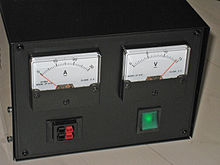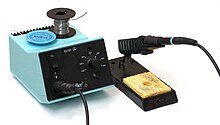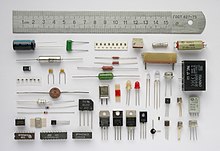Hobby electronics


Hobby electronics refers to the electronic tinkering in the spare time and generally the hobby occupation with electronics , especially with electronic circuits , assemblies and devices .
Hobby electronics engineers build electronic devices or device parts themselves or repair or modify existing, industrially manufactured devices. The circuits and circuit diagrams required for this can be found, for example, in electronics magazines, in hobby and specialist books, on the Internet and in data sheets from manufacturers of electronic components . Experienced electronics hobbyists design or modify such plans and templates themselves, the spectrum ranges from, for example, a simple incandescent lamp or LED control to their own design of computers or hi-fi audio amplifiers . Electronics hobbyists often have in-depth knowledge of analog and / or digital technology , often also of computer technology and its programming at system level .
Fields of work
Hobby electronics deal with, for example:
- the reproduction of circuits with electronics experiment kits (no soldering),
- the production of a device suitable for everyday use from kits or according to a circuit diagram and often including the own production of the circuit board ,
- the development of own circuits and assemblies,
- the programming of microcontrollers ,
- the repair and fault analysis of devices,
- the development of software in connection with self-built computer hardware ,
- the development of own computer peripherals, combined with the development of the associated software,
- the development of mechatronic systems that use sensors and actuators to control moving equipment.
Beginners can use ready-made kits and experiment kits that only need to be put together. Experienced people use professional tools , CAD - software (here Electronic Design Automation ), calculation tools and materials to design circuits to dimension and design circuit boards from it and sometimes to manufacture themselves.
The interests of an electronics hobbyist are often limited to a certain technical area. Some only build hi-fi devices, others make extensions for computers themselves. In computer technology, the associated control software is often created in-house. Still others concentrate on radio receivers, measuring devices , trying their hand at television repairs or just tinkering with entertaining electronic gadgets.
Occasionally, making electronics can be part of another hobby. For example in model making , in hobby meteorology , in the construction of effects devices for musicians or in amateur radio .
Electronics hobbyists who deal intensively with the hardware and software of computers or computerized devices such as cell phones or game consoles and sometimes modify both are also referred to as hackers if they have the appropriate attitude and motivation . There is sometimes an overlap with the subculture of network hackers who penetrate foreign computer networks out of the joy of experimentation .
history
The hobby arose from radio handicrafts : In the early days of radio , radio receivers were hardly affordable for private individuals. However, the amplitude modulation that was used exclusively at the time allowed radio receivers to be built by themselves with relatively few resources; the simplest example is the detector receiver . A well-known supplier of components was Radio Rim in Munich from 1922 to 1991 . The best-known German author of hobby electronics and electronic craft books is the engineer Heinz Richter .
Radio amateurs not only built their receivers, but also transmitters themselves - they are the only radio service that has the right to operate them without any special acceptance or testing. Today, however, radios are also manufactured industrially and are available with much more complex functionality, so that only a few radio amateurs build complete transmission systems. For many radio amateurs, however, building accessories and antennas is still an integral part of their hobby. Since there are amateur radio clubs and youth amateur radio groups nationwide, you can quickly find contacts here if you have questions about electronics tinkering as a beginner.
Electronics tinkering, like commercial electronics, received a considerable boost from the spread of inexpensive transistors . The operation required voltages decreased in contrast to those of tube technology to safe for human values and the mechanical structures simplified it. Another development took place with the availability of inexpensive operational amplifiers and TTL logic modules.
With the advent of do-it- yourself and home computers from the mid-1970s - a little later in Europe - and later with PCs , the hobby lost some of its attractiveness. Many hobbyists turned more to software and did less soldering themselves. It was not uncommon for a simple, self-made computer to be the first step into computer technology. In this respect, electronics hobbyists anticipated today's trend of replacing hardware with software very early on . Ready-made, inexpensive complete offers for computers have reduced the number of those who put their computers together from individual components themselves. Trade fairs like the “ Hobbytronic ” in Dortmund or the “Hobby und Electronics” in Stuttgart have developed into information technology and entertainment electronics events .
In general, electronic handicrafts are exposed to constant technological change. This can constantly pose new challenges for electronics hobbyists. Two of these challenges at the beginning of the 21st century, the progressive spread of highly miniaturized SMD -Bauteilen, designed mainly for production machines and are technically difficult to process and repair, and the ongoing proliferation of programmable logic devices , the programming skills and require a programming environment that is often very expensive to purchase .
Hobby electronics are also used in model making and model railway systems. The lighting and control of the models can partly be realized with individually manufactured hobby electronics. Hobby electronics can be used in self-made mechatronic systems together with electromechanical actuators such as model building servos , motors and electromagnets .
Electronics tinkering has developed into an important part of maker culture in recent years , as can be seen from the high proportion of electronics projects in maker magazines such as Make: or at Maker Faires .
requirements
Skills

An electronics hobbyist should know the function of the electronic components used , but not necessarily their internal structure or mode of operation. He should also be able to read electronic circuits and recognize how they work. Basic mathematics, physics and electronics skills are helpful, but not absolutely necessary. In order to join the components together permanently, manual skills and skill are necessary. This includes soldering by hand as well as knowledge of the associated dangers (pollutants, risk of fire). The manufacture of printed circuit boards requires the handling of substances, some of which are harmful to health, as well as the knowledge required for their environmentally friendly disposal.
equipment
The hobby equipment is similar to that of an electronics laboratory. In addition to precision engineering tools and one or more soldering stations (for coarse and fine soldering), this includes:
Measuring equipment
Devices for current and voltage measurement ( e.g. multimeters ) or an oscilloscope are required . Multimeters often have extended measurement options (frequency, capacitance or temperature).
Power supplies and signal sources
When working with mains voltage, the power supply should contain a residual current circuit breaker and / or an isolating transformer . A laboratory power supply , which has separate setting options for current and voltage, is helpful for working with low voltage. When working on audio amplifiers or the like, a low frequency source is helpful: This can be a function generator or a tone generator . For processing ESD- sensitive components (including MOSFETs , highly effective light emitting diodes , laser diodes , ICs ), ESD equipment (conductive mat, wrist earthing strap , suitable tool) and an earthed soldering iron are desirable in order to avoid destruction by electrostatic charges.
PCB manufacturing
In-house production of printed circuit boards (circuit boards) is increasingly rare. In the mask process, it requires bowls for chemicals and, for this purpose, a storage cabinet that is inaccessible to children. In the simplest case, an acid-proof pen is required to manufacture the mask. In the case of lithographic production, an ultraviolet exposure device and a method for film production (formerly Indian ink, now copier or laser printer) are required. Alternatively, circuit boards can be milled by hand or with a milling plotter. Self-designed circuit boards can also be commissioned from circuit board manufacturers for production; these produce prototypes and small series in the best quality and master technologies such as through-hole plating and multi-layer layouts. Often, however, electronic circuits are implemented using threading or winding technology or on grid plates (laboratory boards).
Connection techniques
When it comes to experimental circuit designs with a short lifespan, various clamping or plug-in techniques are often used instead of soldering. There are various commercial variants of experiment kits with breadboards (for example from Franckh-Kosmos , Philips or Braun ). Even for hobbyists there are ready-made so-called plug -in boards (“Put In”) for free assembly and wiring. For simple structures with only a few, large, discrete components, you can even use luster terminals as connecting elements (see illustration). Even “flying structures”, in which the components are simply connected to alligator clips using laboratory cables , are conceivable.
Hobbyists use such simple methods as well as the commercially used techniques such as threading technology, winding technology (no longer widespread), milling plotters or the prototype production offered by circuit board manufacturers.
When soldering, free ("flying") wiring was initially used, with connections from tube sockets, various other permanently mounted components, as well as soldering strips and soldering pads for mechanical fixation. This technique was used until the 1950s . It was suitable for in-house designs, but was also found in commercial production at the time. The manufacture of tube devices has been made easier by metal chassis with corresponding recesses for tube sockets.
The next step was circuit board technology, which was mainly used for discrete transistor circuits, but was also used for tube devices. The layout of the circuit boards at that time including its disentanglement was pure craftsmanship and drawing. Only later, with the advent of computers and software for creating and disentangling circuit board layouts, was manual work replaced professionally. Although the professional still occasionally uses rub symbols for simple circuit boards in the 21st century, the circuit board layouts are usually only designed with the computer. Hobby electronics, on the other hand, still use the simple means of producing circuit boards today. The simplest method for individual pieces is to draw a layout directly using an acid-proof felt pen on a copper-clad circuit board and then etch it. The self-exposure of photosensitive coated base material using templates that you have drawn yourself or created on the computer or using templates from electronic magazines, for example, is somewhat more complex. The necessary equipment (devices for exposure and etching) can be purchased cheaply in electronics stores.
Ready-to-use printed circuit boards are usually included with kits. For circuits with integrated circuits , specially designed experimental boards are available, which distribute the small connection spacings ( pitch ) widely over individual soldering eyes, so that even SMD ICs can be used for hobby electronics. So-called “breadboard boards” are available for handicrafts and prototype production (see illustration). They have holes in a grid of 2.54 (sometimes also 2.50) or 5 mm and around each hole a small copper circular area as a soldering area ("solder pad"). The components are connected to one another either freely with jumper wire or using threading technology.
Instead of the breadboard with individual soldering points, there are also designs in which the holes in a row are connected through in the form of a strip ("strip circuit boards"). Special, screwdriver-like tools for cutting the conductor strips are available for cut-off points that are necessary in terms of circuit technology. Perforated boards are offered with one and two layers as well as non-plated and plated-through holes. They often have the Euro card format 100 × 160 mm and are also offered with a Euro card connector layout on the front, guided on soldering eyes.
Educational and economic aspects
Depending on the practical activities carried out, the hobby can promote the learning of manual skills and also the acquisition of specialist knowledge, both of which can be useful for later vocational training, for example for the professional fields of electronics technician , software development , metal construction or locksmithing . The acquisition and interdisciplinary application of theoretical knowledge - from Ohm's law and its application, through the development of algorithms and their implementation to the planning and logistics of larger projects - includes many skills of an engineering profession.
Working groups at schools also deal with electronic projects. They are led by experienced specialist teachers or private individuals. Many famous inventors, developers in industry or heads of large companies in the field of their former hobby were previously electronics hobbyists.
Many companies devote themselves to the development, manufacture and delivery of electronic components and assemblies. Most of the time they supply electronics laboratories or the prototype or sample production facilities of industry and research as well as general schools, vocational schools and universities. Provider with Wikipedia articles Conrad Electronic (3900 employees), ELV Elektronik (1000 employees), Reichelt Elektronik (220 employees).
literature
Magazines
Discontinued publications
- elex
- ELO (discontinued 1989)
- Elrad (discontinued 1997)
- Popular electronics
Books
- Norbert Adolph (Ed.), Jean Pütz : Introduction to Electronics. The book based on the television series of the same name. Fischer-Taschenbuch-Verlag, Frankfurt am Main 1993, ISBN 3-596-26273-9 .
- Klaus Kleemann: Digital electronics for beginners. An introduction to digital electronics through theory and practice. 7th edition, Franzis, Munich 1988, 142 pages, ISBN 3-7723-1797-9 .
- Dieter Nührmann, Electronics - what is it? A fun introduction for beginners to the secrets of practical electronics. 2nd improved edition, Franzis, Munich 1987, 309 pages, ISBN 3-7723-7272-4 .
- Heinz Richter : Electrical engineering for boys. An introduction through self-assembly and experiments that everyone succeeds . 1964.
- Heinz Richter: Electronics in self-construction and testing . 1966.
- Heinz Richter: radio crafts for boys . 1968.
- Heinz Richter: The big transistor handicraft book. Instructions for self-construction of over 100 simple transistor devices . 1971.
- Hellmuth E. Wolf: Electronics tinkering for advanced users. Advanced knowledge of electronic components and many switching examples for advanced hobbyists; Amplifiers, alarms, controls, games and much more. Humboldt-Taschenbuchverlag, Munich 1987, ISBN 3-581-66560-3 .
- Florian Schäffer, electronics experiments for kids . Mitp Verlag , Frechen 2016, ISBN 978-3-95845-368-5 .
- Adrian Schommers: Electronics are not difficult at all. Elektor, ISBN 978-3-921608-32-6 .
Web links
- Electronicsplanet, hobby electronics, microcontrollers and robot construction. Retrieved December 11, 2016 .
- The Elektronik-Kompendium.de is the website about electronics, computer technology, communication technology and network technology for schoolchildren, trainees and students. Patrick Schnabel, accessed March 3, 2017 .





